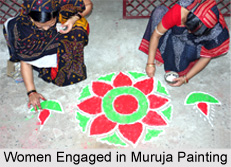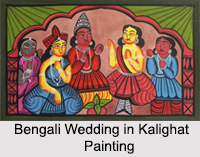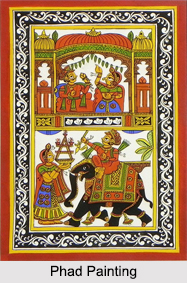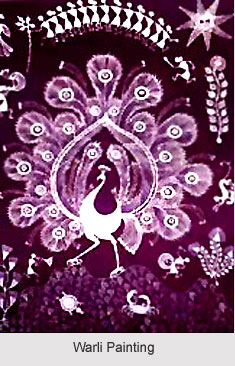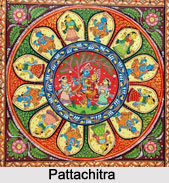 Traditional Indian Paintings are as old and varied as the land itself. The painting as a form of art has started in India since the prehistoric times. The earliest paintings in India is found on the walls of the caves in Bhimbetka in Madhya Pradesh where the prehistoric men engraved and painted the scenes from game, the animals and man in the simple geometric lines and colours on the cave walls.
Traditional Indian Paintings are as old and varied as the land itself. The painting as a form of art has started in India since the prehistoric times. The earliest paintings in India is found on the walls of the caves in Bhimbetka in Madhya Pradesh where the prehistoric men engraved and painted the scenes from game, the animals and man in the simple geometric lines and colours on the cave walls.
Traditional Indian Paintings are India`s pride. They truly replicate India`s ancient tradition and inheritance. Since time, these paintings have decorated the walls, homes and courtyards of the villagers, people and tribals. Indian traditional paintings present an artistic range which expands from the early development to the present day. From being basically spiritual in reason in the establishment, Indian painting has developed over the years to turn out to be a combination of various cultures and traditions.
History of Traditional Indian Painting
Opening with the ancient rock cut paintings and murals, the Indian art traditions range around 8,000 years. Bhimbetka caves in Madhya Pradesh are the best example of pre-historic cave paintings and murals. The paintings of Indus valley was more preceded and it was during this time that the better paintings tools and techniques were developed. The subject and themes of paintings were quite fundamental. It is assumed that it was throughout this period only that people had started to paint and carve their deities. The influences of cultures and more significantly, the spiritual beliefs of the artists are quite apparent in their paintings.
Themes of Traditional Indian Painting
Themes of Traditional Indian Painting include representation of festivities, occasions, and gatherings. The themes are various and consist of a portrayal of hunting parties, war scenes.
Types of Traditional Indian Painting
The different forms of traditional painting in India is therefore vivid and lively, refined and sophisticated, while bold and vigorous at the same time and still have the aesthetic value to the connoisseurs and art-collectors of India and abroad. Indian traditional paintings can be generally divided into following categories:
Miniature Paintings: The initial miniature paintings in India were set up on palm leaves. These pieces were generally painted for Jain and Buddhist merchants. These early miniatures, regarded as Pala and Jain, were pursued later by diverse schools of art such as Rajasthani, Mughal, Pahari and Deccani miniatures, each of them have their own feature style and individuality.
Patachitra: It is one of the original art forms dating back to the 12th century from Odisha. Lord Jagannath is typically the chief theme of patachitra. Other themes consist of the story of Radha-Krishna, scenes from Ramayana and Mahabharata, temple activities and others.
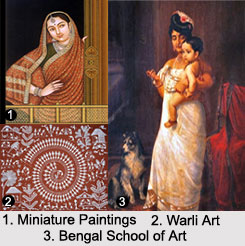 Thanjavur Paintings: A Thanjavur painting is a multi-coloured sheet painting done on a wood plank with a deity as the major theme of the work of art. Thanjavur paintings are an antique art which flourished in the South Indian town of Thanjavur in Tamil Nadu between the 16th and 18th centuries.
Thanjavur Paintings: A Thanjavur painting is a multi-coloured sheet painting done on a wood plank with a deity as the major theme of the work of art. Thanjavur paintings are an antique art which flourished in the South Indian town of Thanjavur in Tamil Nadu between the 16th and 18th centuries.
Warli Art: Warli paintings are done within the walls of huts and implemented with a simple style. Warli art belongs to one of the chief tribes in the Western state of Maharashtra, the Warlis. This art form typically portrays pictures of the tribal daily life and different forms of nature such as the sun, moon and rain accompanied by a feature absence of any mythological or spiritual figures.
Cave Painting: Cave paintings of India dated back to the ancient times. The supreme examples of these paintings include of the murals of Ajanta, Ellora, Bagh, Sittanavasal, etc, which reproduce an importance on naturalism.
Mysore Painting: Mysore Painting is a structure of traditional South Indian painting, which developed in the Mysore city of Karnataka.
Madhubani Painting: Initially, the womenfolk of the village drew the paintings on the walls of their home, as a picture of their beliefs, hopes and dreams. With time, the paintings started fetching a part of festivities and individual events, like marriage.
Pahari Painting: These painting developed with flourished in the period of 17th to 19th century. Pahari painting is the name given to Rajput paintings, made in the in the Himachal Pradesh and Jammu & Kashmir states of India.
Bengal School of Art: The Bengal School of Art is a significant style of art that flourished in India during the British Raj in the early 20th century. It was associated with Indian patriotism, but was also encouraged and supported by many British arts administrators.

